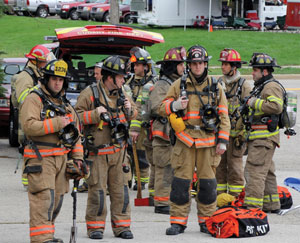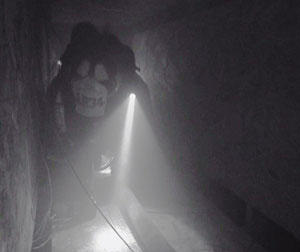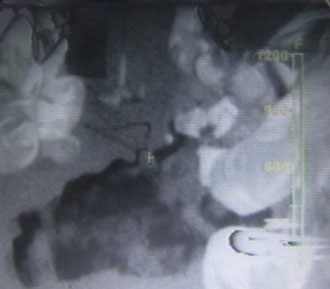By Joe Pulvermacher
Scenario: You–Firefighter Smith–have just been involved in a building collapse. You’re stuck! With some effort, you are able to access your radio. You radio: “Mayday, Mayday, Mayday … Smith … Oak Creek Engine 1 … trapped … unable to get out … cannot contact crew … first-floor fire attack … on red preconnect … half tank of air … send RIT [rapid intervention team].”
Dispatch responds: “All units from command … stand by for emergency traffic … Smith from Engine 1 is trapped on the first floor … location of Engine 1 crew unknown … North Shore RIT, you will make entry … follow the red preconnect … Smith has a half tank of air … all units stand by for a PAR.”
Command responds: “Staging from command … send up another crew to stand by as RIT.”
A RIT from another department is now coming to get you. Do they know your self-contained breathing apparatus (SCBA)? Can they communicate with you? Have they been trained to remove a firefighter in full turnout gear? What equipment are they bringing IN to get you OUT?
Background
During the initial stages of an active fire attack, suburban fire departments will often assign all available responding units to the firefight including fire attack, search and rescue, ventilation, backup line, and various command functions. RITs have been an important aspect of the fire service for the past couple of decades. During that time, there have been many debates about staffing and the appropriate number of personnel needed during a RIT activation. The act of having firefighters available to rescue other firefighters has constantly evolved.
The Milwaukee County (WI) Mutual Aid Box Alarm System (MABAS) Division 107 is comprised of 14 suburban fire departments that surround the City of Milwaukee (MABAS Division 109). Although Milwaukee has a well-established RIT procedure that uses Milwaukee (WI) Fire Department (MFD) units on the initial dispatch, suburban departments have limited local resources immediately available for rapid intervention assignments. With that in mind, the Milwaukee County suburban fire departments needed to develop a standardized, collective approach to RIT. What do you do when your department has fewer than two or three companies responding on the initial alarm? What happens when your department relies on mutual-aid companies to assume basic firefighting tasks on the fireground? What happens when your incident is too large for only one RIT?
It is not uncommon for smaller, suburban, or rural departments to rely on a mutual-aid response for the rapid intervention assignment. Many times, mutual-aid response cards are developed with RIT tasks already assigned to a neighboring fire department. The problem in Milwaukee County was that the RIT response was not standardized or predictable; it was not unusual for some departments to staff a RIT assignment with just four, three, and sometimes two firefighters. Further, the cache of tools and equipment staged with the RIT varied. It was fairly common to see teams with too much or not enough equipment.
The Milwaukee County Association of Fire Chiefs tasked its training officers association to develop a standard response. The training officers were directed to draft a standard operating guideline (SOG) complete with staffing and equipment requirements. Further, the training officers were also responsible for developing a training and an evaluation module. That way, all participating fire departments had specific directions to train their firefighters with a common SOG and lesson plan.
Preparations
In 2008, the Milwaukee County training officers met to put together a list of best practices and to draft an SOG. As members of the MABAS, the training officers designed the SOG for a standardized, divisional response and placed the guideline on the MABAS Division 107 SOG template. Using the divisional template required a coordinated effort. No single department had sole influence on the outcome of the guideline; it needed to be a collaborative project.
By the end of 2008, the training officers presented a draft of the first version of the MABAS Division 107 RIT SOG. In addition to deployment requirements, the SOG provided recommendations for staged equipment. Not all departments had the equipment specified in the document. Once again, variables existed in the actual response. With the SOG in place, funding mechanisms were evaluated to purchase “like” equipment. In 2009, Milwaukee County wrote and was awarded an Assistance to Firefighters Grant to equip all suburban Milwaukee County fire departments with standardized RIT equipment.
In October 2009, to address the training component of the fire chiefs’ mandate, two representatives from each suburban Milwaukee County fire department were sent to a week-long RIT Operations train-the-trainer class in Indianapolis. This class, held at the Fire Department Training Network (FDTN), was intended to evaluate equipment familiarity and operational effectiveness. Class participants were then tasked to develop training modules that could be replicated by each department. The train-the-trainer program provided the baseline for firefighter survival and rapid intervention.
By the summer of 2010, all training modules were finalized and approved. In fall 2010, the modules were released to each of the suburban Milwaukee County fire departments, and training was initiated. Training officers were given one year to accomplish the recommended training. Props were built, training schedules were developed, and SCBA familiarization was conducted (not all departments had the same SCBA specification).
While training was distributed to every Division 107 firefighter, the Milwaukee County Fire Training Officers Association (MCFTOA) addressed a couple of administrative details. The first thing needed was a revision of the SOG, adapting the content to reflect information learned through the RIT train-the-trainer program. Revisions finalized and approved in January 2011 gave specific attention to the following sections of the guideline:
- RIT operational checklist (staged tool inventory).
- Team activation and deployment procedures.
- Team positions and assignments.
Another administrative function was to address the command aspect of a RIT response. Most of the Milwaukee County training modules concentrated on operational components of RIT with curriculum addressing the need to develop effective rapid intervention management.
In May 2011, the MCFTOA organized a “Commanding the RIT” seminar. All area departments were invited to participate. We asked FDTN’s Jim McCormack to convey the incident command message for RIT operations. From a training perspective, this provided our firefighters with a consistent message, and it reinforced our training platform. The intent was to operationally support the RIT activation through effective fireground leadership. The final component of training was to provide an interdepartmental exercise. Our observation of actual incidents was that smaller fire departments were using neighboring mutual-aid responders to staff RIT operations. And although larger fire departments generally used their own firefighters to staff RIT, mutual-aid companies were used to support and supplement the RIT response because of the labor-intensive nature of firefighter rescue.
In December 2011, the MCFTOA presented a plan for a multidepartment RIT training scenario. At that point, firefighters were familiar with firefighter rescue techniques and had practiced them at the local level. Once the divisionwide drill was approved, an exercise was written to reflect a multidepartment RIT activation. The scenario was designed to overwhelm the initial RIT company so that additional RIT teams would be required to achieve firefighter rescue.
Multidepartment Exercise for Regional RIT
All suburban Milwaukee County fire departments were invited to participate in the RIT exercise. Each department dedicated at least one four-person crew. Scenarios were repeated so that multiple companies had access to the training. The overall intent of the training was to provide a mechanism for fire departments to evaluate the effectiveness of their RIT practices and to ensure that they were consistent with other mutual-aid departments. All fire departments were encouraged to send RIT instructors trained through the train-the-trainer program. For safety purposes, we wanted to make sure that the instructor-to-student ratio was manageable and that instructors were provided with more instructional opportunities to maintain their skill set. RIT instructors functioned as instructional observers and operated independently, not as RIT members.
Training Environment
An empty cold storage warehouse was used to construct the training environment. Training smoke was used to diminish visibility. RIT training props were used to simulate building collapse, wire entanglement, reduced profile, and other obstacles. Training was designed so that search ropes were essential and based on building layout and victim location.
 |
|
(1) Milwaukee County (WI) Mutual Aid Box Alarm System’s Division 107 rapid intervention team’s (RIT’s) command operations. [Photos courtesy of the Milwaukee County (WI) Fire Training Officers Association.] |
Incident command was established outside of the building and functioned out of a command vehicle, using a command board to keep track of accountability and training assignments. RIT companies were prestaged and called up at the request of the RIT group supervisor (photo 1).
A safety briefing was conducted prior to the start of evolutions to share training objectives, provide an opportunity for last-minute questions, and announce ground rules. All training elements, including rehab, were discussed (photo 2).
 |
| (2) Pre-exercise safety briefing. |
Activities Reinforced
Using the Division 107 RIT SOGs, the following five RIT positions were reinforced:
- RIT group supervisor. Responsible for team management and communication to the incident commander (IC). The RIT group supervisor remained outside.
- RIT officer. Coordinates team activities and communicates with the RIT group supervisor.
- Navigation/Air supply. Secures tag line, transports RIT SCBA, and assists with victim removal.
- Search 1. Aggressively searches for victims. Updates RIT officer.
- Search 2. Aggressively searches for victims. Updates RIT officer.
Once the victim was located, the firefighter who found the victim applied the RIT air supply, fashioned the SCBA straps into a drag harness, and assisted with removal. At the same time, the second search firefighter attempted to locate a second means of egress and secure the tag line.
Although the primary focus of this exercise was aimed at the task level, it was clear that chief officers gained valuable experience in RIT activation procedures and on-scene communication. The following incident command functions were also emphasized:
- Staging. Established personnel readiness and crew rotation.
- Incident command. Coordinated on-scene activities between RIT group supervisors (photos 3-6).
Lessons Learned
Training point #1: Communications. Teams should meet with the RIT group supervisor and the next-in team to explain conditions, actions, needs, and status. Involving the RIT group supervisor will help establish task objectives and incident priorities. If the RIT group supervisor has this information, he can brief additional teams prior to entry. Continuous benchmark reports and hazard/condition reports will also assist with fireground efficiencies.
 |
| (3) RIT staging area |
Training point #2: RIT crew advancement and victim packaging. Tag line discipline will prevent confusion. Use separate anchor points when deploying multiple tag lines. In situations where you need multiple tag lines to get deeper into the building, find a different entrance (if possible). Another possibility (for larger structures) is to use one main tag line to find an anchor inside the building where you can secure other tag lines. RIT companies are reminded that crew members do not have to remain in physical contact. Spreading out is appropriate as long as members remain in visual or voice contact. The RIT officer needs to be responsible for crew integrity. Here, the thermal imaging camera is a valuable tool for the RIT officer (photo 7).
 |
| (4) RIT staging area |
All companies did a great job of locating and packaging the down firefighters; however, most teams did not stop and listen for a personal alert safety system (PASS) alarm when they entered the structure. Additionally, when a down firefighter needed to be left in place before another RIT company could advance to that location, some RIT companies did not secure the tag line to a close anchor point, while some RIT companies did not leave the RIT SCBA behind for the victim.
 |
| (5) Staged equipment |
Training Point #3: Air management. Personnel managing a RIT activation must be aware of their team’s air supply. Be cautious! Do not get too deep in the building without evaluating egress potential. Crews should avoid using their own air supplies to supplement the air supply of a down firefighter, especially when a rescue air supply is immediately available. Do not hesitate to call a Mayday if you are concerned about yours or another firefighter’s air supply.
Training Point #4: Incident command and standardization. Regularly conduct multicompany/multidepartment exercises to reinforce the MABAS concept of a standardized response. Incident command philosophies are similar but not the same. Common terminology for command functions (RIT chief vs. RIT supervisor) would reduce confusion.
Following are more points on standardization:
- Clipboards, command boards, and tracking processes should be the same within the division.
- Share methods of handling incident command. Departmental nuances contributed to operational confusion. You need to practice using the same terminology.
- Make radio channel selection uniform. We discussed selecting and switching tactical channels.
- The command function checklist should be the same throughout the division.
Action Items
All told, the development of a standardized RIT in Milwaukee County was a success. Common guidelines, procedures, and training were all proven and reinforced through an evaluative process. We expected the unexpected and provided all participating fire departments with the following to consider for future training projects:
We developed and released an after-action report to the Milwaukee County chiefs; this exercise represented the culmination of regional training applied at the local level. Individual departments participated in the delivery of a standardized RIT curriculum. The after-action report provided fire department administrators documented progress of RIT operations and suggestions for improvement. The report was shared with all firefighters–regardless of rank–who participated in the exercise. The training officers see this training as an opportunity to highlight the need for standardized incident command operations. Although every Milwaukee County fire department is compliant with the National Incident Management System, we recognized command and communications as “areas of improvement.” A workgroup is being established to provide direction for further training opportunities.
 |
| (6) Crew advancement through entanglement prop. |
The MFD was not involved in the RIT grant or the subsequent training exercise. The purpose of this training opportunity was to develop a standardized approach among fire departments that rely on mutual aid for rapid intervention. Through a developing shared services approach, the MFD is becoming more involved in suburban incidents and response. Our SOG must provide the flexibility to address future response partnerships.
 |
| (7) RIT packaging a victim as observed by a RIT officer through a thermal imaging camera. |
Never underestimate the value of realistic training. Suburban fire departments rarely fight fires alone; training should mimic that reality. In this example, years of preparation culminated in a successful exercise. Moreover, we have seen the value of that effort on the fireground. We challenged our capabilities, trained hard, and made an operational impact on firefighter safety. We owe that to ourselves and our fellow firefighters.
JOE PULVERMACHER is the battalion chief of training for the Oak Creek (WI) Fire Department. He has a bachelor’s degree in fire service management and is certified as a State of Wisconsin Level II fire officer and Level II fire instructor. Pulvermacher is an executive fire officer at the National Fire Academy and serves as the president of the Milwaukee County (WI) Fire Training Officers Association.
To request information go to fireeng.hotims.com
Fire Engineering Archives

